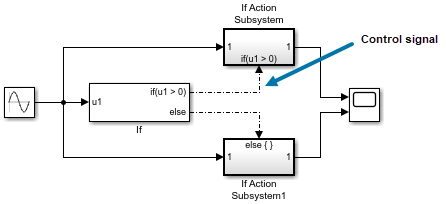信号类型
许多类型的信号都可以连接模型中的模块。例如,一个模型可以包含控制信号来启动一个模块和总线的执行,以简化布线。
下表总结了 Simulink® 信号的类型。
| 名称 | 描述 |
|---|---|
| 数组 | 一维或多维非标量信号。 |
| 总线数组 | 包含非虚拟总线的数组。 |
| 总线 | 具有基于名称的信号访问的合成信号。 |
| 合成信号 | 由其他信号组成的信号。请参阅合成信号。 |
| 串联信号 | 具有基于索引的信号访问的非虚拟向量、矩阵或数组。 |
| 控制信号 | 模块用于启动另一个模块的执行的信号。例如,用于执行函数调用子系统或运行执行子系统的信号。请参阅控制信号。 |
| 矩阵 | 二维非标量信号。 |
| 多维(N 维)信号 | 三维或多维数组。 |
| 复路信号 | 具有基于索引的信号访问的虚拟向量。 |
| 非标量信号 | 具有至少一个维度的信号,例如向量(一维)、矩阵(二维)或多维数组(N 维)。 |
| 非虚拟信号 | 在仿真和代码生成中起主要作用的信号。请参阅虚拟和非虚拟信号。 |
| 标量信号 | 一次仅支持一个值的信号。 |
| 可变大小信号 | 指除信号值外,其信号大小(一个维度中的元素数)在模型仿真过程中也可发生变化的信号。 |
| 向量 | 一维非标量信号。 |
| 虚拟信号 | 表示另一个信号或一组信号的信号。请参阅虚拟和非虚拟信号。 |
注意
信号也可以具有特定于应用的类型,例如本地风速。要根据特定于应用的类型分配或验证信号的单位、最小值、最大值、维度和其他属性,请参阅Specify Common Set of Signal Properties as Value Type。
控制信号
控制信号是模块用于启动另一个模块的执行的信号。例如,用于运行一个函数调用子系统或一个执行子系统的信号是控制信号。在更新或仿真模块图时,Simulink 使用点划线模式绘制表示控制信号的线。

合成信号
您可以将多个信号组合成一个合成信号,在各模块之间传送信号,并在需要时提取组成信号。当您有许多并行信号时,合成信号可以简化模型的外观并使生成的代码更清晰。合成信号可以是虚拟的,也可以是非虚拟的。
有关合成信号的详细信息,请参阅合成接口规范。
虚拟和非虚拟信号
虚拟信号是一种信号,它以图形方式表示其他信号或其他信号的一部分。虚拟信号不存在于生成的代码中。有些模块(如 Mux 模块)始终生成虚拟信号。有些模块(如 Bus Creator 模块)既可以生成虚拟信号,也可以生成非虚拟信号。如果生成信号的模块是虚拟的,则信号是虚拟信号。
非虚拟信号是一种在仿真和代码生成中起主要作用的信号。有些模块(如 Vector Concatenate 模块)始终生成非虚拟信号。如果生成信号的模块是非虚拟的,则信号是非虚拟信号。
有关虚拟和非虚拟模块的信息,请参阅非虚拟和虚拟模块。